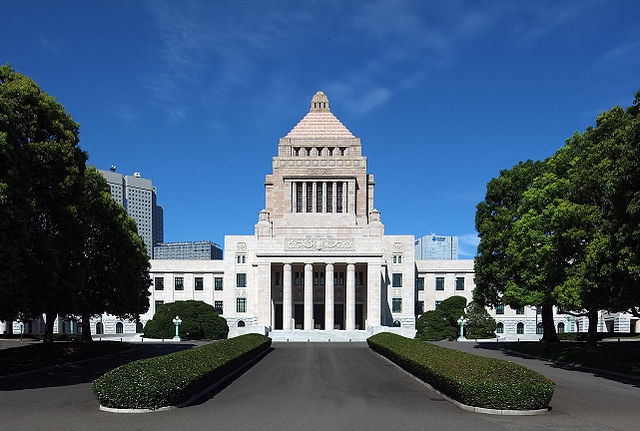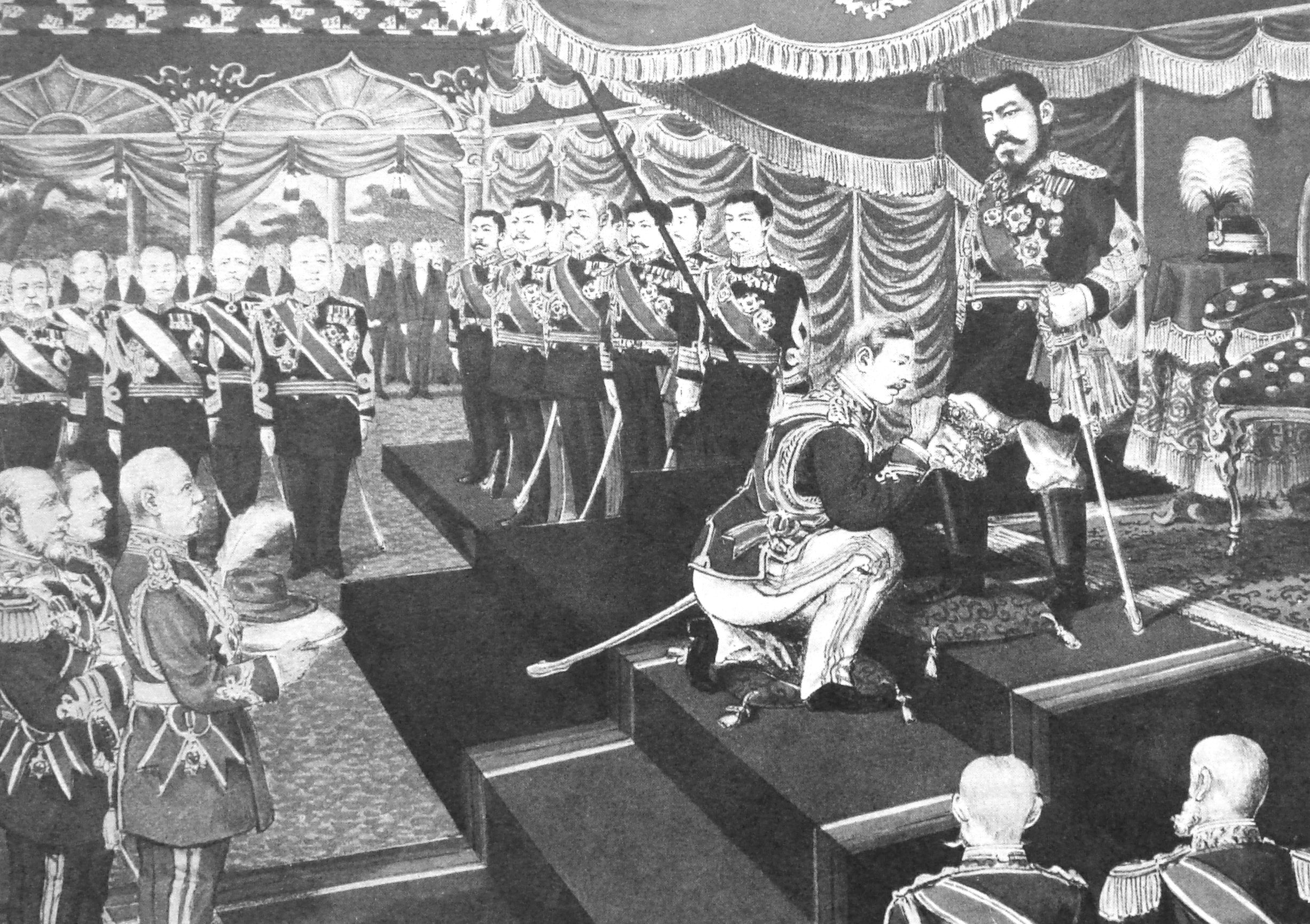It looks like you're using an Ad Blocker.
Please white-list or disable AboveTopSecret.com in your ad-blocking tool.
Thank you.
Some features of ATS will be disabled while you continue to use an ad-blocker.
share:
After 60 yrs of non-interference in global military affairs Japan is set to pass the controversial Defence Bill which will fly in the face of Japans'
own constitution, and mean that Japanese forces could be deployed overseas. This proposal has seen daily protests and scuffles and in-fighting in
Japans parliament for weeks but in the end the policies have been approved.
Chaos In Japans' Parliament
After the second world war, Article 9 was added to the Japanese constitution forbidding military intervention and forbidding the country from having a navy army or airforce so in 1950 when the Americans pulled out of Japan to serve in Korea, the Self-Defense Force was set up with the approval of the Allied Command for the protection of Japan and its people but with strict rules regarding weapons and weaponisation.
In 2014 Japan moved to re-interpret the Constitution which apparently alarmed China and North Korea but was approved by the USA.
Could this change in stance by the Japanese have anything to do with North Korea's posturing? Could this mean that Japan could well be assisting the USA et al in the middle east conflicts? Or as the article suggests a reaction to China's presence in the South China Sea. I guess only time will tell but it will be hard to swallow by the majority of pacifist Japanese
Chaos In Japans' Parliament
After the second world war, Article 9 was added to the Japanese constitution forbidding military intervention and forbidding the country from having a navy army or airforce so in 1950 when the Americans pulled out of Japan to serve in Korea, the Self-Defense Force was set up with the approval of the Allied Command for the protection of Japan and its people but with strict rules regarding weapons and weaponisation.
In 2014 Japan moved to re-interpret the Constitution which apparently alarmed China and North Korea but was approved by the USA.
Could this change in stance by the Japanese have anything to do with North Korea's posturing? Could this mean that Japan could well be assisting the USA et al in the middle east conflicts? Or as the article suggests a reaction to China's presence in the South China Sea. I guess only time will tell but it will be hard to swallow by the majority of pacifist Japanese
The current leadership is young enough to have forgotten the lessons of their last Great War. Two words that make blood run cold. Hiroshima and
Nagasaki. People who are reluctant to study history are doomed to repeat it.
I think half a century is enough time in the dog house.
After all, when the US goes down the toilet, who will defend them. They would be sitting ducks.
I think it is time for them to take their place again in world affairs. They are not the same people that started the war in the Pacific.
Germany has moved on and is one of the dominant forces in Europe.
P
After all, when the US goes down the toilet, who will defend them. They would be sitting ducks.
I think it is time for them to take their place again in world affairs. They are not the same people that started the war in the Pacific.
Germany has moved on and is one of the dominant forces in Europe.
P
Strange how the 2 countries that were forbidden from having a standing armed force are the 2 countries that have come on in leaps and bounds
outstripping all the Allies in manufacturing production and economies
I already seen the ending. Japan will be sacrificed, brothers and sisters will perish, Korea will lead.
I do wonder though if some nation outside Japan has pushed for this in order to gain a new ally in the East? Its a thought ) not that I'm suspicious
you understand
Good for Japan,
They've spent 70yrs on the right side of the world since WWII.
Many nations committed atrocities in that war, including the United States and UK.
Japans people are peace loving now, smart and should be able to contribute.
They understand better than anyone the consequences of military conquest so id say they are the ones least likely to do it.
They've spent 70yrs on the right side of the world since WWII.
Many nations committed atrocities in that war, including the United States and UK.
Japans people are peace loving now, smart and should be able to contribute.
They understand better than anyone the consequences of military conquest so id say they are the ones least likely to do it.
a reply to: Agit8dChop
Contribute to what? Making less peace? I don't understand your post. If peace lovers contribute to making more war, they're no longer peace lovers.
As for the OP, I think this may be a sign of what's coming. Another world war. Why else would Japan rewrite its Constitution in order to allow its military to go overseas? Looks like they're preparing to get into conflict.
Contribute to what? Making less peace? I don't understand your post. If peace lovers contribute to making more war, they're no longer peace lovers.
As for the OP, I think this may be a sign of what's coming. Another world war. Why else would Japan rewrite its Constitution in order to allow its military to go overseas? Looks like they're preparing to get into conflict.
originally posted by: PhyllidaDavenport
Strange how the 2 countries that were forbidden from having a standing armed force are the 2 countries that have come on in leaps and bounds outstripping all the Allies in manufacturing production and economies
It is not strange at all.
After having been bombed out of existence, they were rebuilt. All of the machinery was brand new and the latest available.
While England made do with equipment that was very old, Germany had all new stuff. So did Japan. Remember that much of Europe was broken and smashed and had no money.
The allies rebuilt Germany and Japan so it is no wonder they started to lead the world in these areas.
Consider also that other countries spent huge sums of money rebuilding their armed forces while Germany and Japan were forbidden from doing so and thus spent their money on manufacturing.
P
a reply to: PhyllidaDavenport
Japan Set To Pass Controversial Defence Bill
Controversial for whom?
I when I saw the head line I thought they were considering declaring war on the people they have worked who did the attacks on their nuc power plants under the cover of a Tsunami at #ishima.
Japan Set To Pass Controversial Defence Bill
Controversial for whom?
I when I saw the head line I thought they were considering declaring war on the people they have worked who did the attacks on their nuc power plants under the cover of a Tsunami at #ishima.
We are seeing here the Western powers moving on the Eastern military pivot.
We will never know the back room deals that put the militarization of Japan into play.
PNAC's Rebuilding Americas Defenses paper outlines a plan to militarily press American Corporate global dominance upon the world.
Fifteen years later we are well underway to their proposition of a century of War.
We have seen in the Middle East the manifestations of their plans.
This paper describes an Asian pivot, a part of America's war on the worlds we have not yet come to.
The end game is to establish a permanent base in North Korea, and eventually surround China and Russia.
So the powers behind the militarization of Japan are likely the same powers militarizing all the Western allies.
www.usnews.com...
www.usnews.com...
These article are from the (salivating) horses' mouths, guys at Rand Corp, and the Carnagie Institute.
It is our friendly neighborhood Military/Industry complex that will be selling Japan their new Military. $$$
Same guys US taxpayers give 500 billion yearly to f up the world with.
The media is telling us that the US approves of this move by Japan, but the truth is that the shadowy military powers behind US GOV pushed hard to make it happen.
We will never know the back room deals that put the militarization of Japan into play.
PNAC's Rebuilding Americas Defenses paper outlines a plan to militarily press American Corporate global dominance upon the world.
Fifteen years later we are well underway to their proposition of a century of War.
We have seen in the Middle East the manifestations of their plans.
This paper describes an Asian pivot, a part of America's war on the worlds we have not yet come to.
The end game is to establish a permanent base in North Korea, and eventually surround China and Russia.
So the powers behind the militarization of Japan are likely the same powers militarizing all the Western allies.
www.usnews.com...
www.usnews.com...
These article are from the (salivating) horses' mouths, guys at Rand Corp, and the Carnagie Institute.
What security changes are likely to unfold? The most probable outcome is increasingly close coordination of Asia-Pacific security strategy among the United States, Japan, Australia and India, as well as with South Korea, the Philippines and other friendly nations.
In discussions with nearly 100 defense and diplomatic officials in Japan earlier this year, we were struck by how determined the leaders of Japan have become to ensure that the Asia-Pacific region evolves toward democracy, free markets and the rule of law — and away from a future dominated by China, with the influence of the United States and Japan marginalized and declining.
Defense-acquisition management. Japan’s capacity for procuring major weapon systems is being reformed and improved. Such changes will help the United States and Japan cooperate more closely in the defense industrial arena, where integrating U.S. experience with Japanese high-technology has long held promise.
• Defense exports, sales and transfers. Japanese transfers of defense equipment are already helping to build partner capacity in countries such as the Philippines and Vietnam that are concerned about China’s efforts to lay claim to most of the South China Sea
It is our friendly neighborhood Military/Industry complex that will be selling Japan their new Military. $$$
Same guys US taxpayers give 500 billion yearly to f up the world with.
The media is telling us that the US approves of this move by Japan, but the truth is that the shadowy military powers behind US GOV pushed hard to make it happen.
It has been passed, despite the opposition jumping on the table to prevent them from signing the bill. It was a sad moment.
I think Japan has been owned by the 'West' for a long time now. .. but now I think they really have them yoked.

en.wikipedia.org...
Does this building look Japanese to you?
I think Japan has been owned by the 'West' for a long time now. .. but now I think they really have them yoked.

en.wikipedia.org...
Does this building look Japanese to you?

The Meiji emperor receiving the Order of the Garter from Prince Arthur of Connaught in 1906


You see those honorific badges? .. those are not Japanese badges.

Shah of Iran
They sort of look like those badges..
a reply to: Nickn3
Learning from history is important, but those bombs that were dropped back then are firecrackers compared to what we have now. If those birds come out of their silos, Japan is not the only one that's in deep sh**.
OP - I think this is more in response to China and their push to build islands in the South China Sea, but I'm betting they've had a little bird [ well actually an eagle wink ] whispering in their ear.
Learning from history is important, but those bombs that were dropped back then are firecrackers compared to what we have now. If those birds come out of their silos, Japan is not the only one that's in deep sh**.
OP - I think this is more in response to China and their push to build islands in the South China Sea, but I'm betting they've had a little bird [ well actually an eagle wink ] whispering in their ear.
a reply to: PhyllidaDavenport
I suspect the West has a great influence in the highest levels of the Japanese Government (from the time before the Pacific War), and suspect the West is the great motivator for this bill which threatens the pacifist articles in Japan's constitution.
The motivation as you mentioned being assisting the West in conflicts.
I suspect the West has a great influence in the highest levels of the Japanese Government (from the time before the Pacific War), and suspect the West is the great motivator for this bill which threatens the pacifist articles in Japan's constitution.
The motivation as you mentioned being assisting the West in conflicts.
a reply to: pheonix358
Is that the same folk that 'liberated' German engineers and scientists to help build their spy planes? Spoils of war I guess.
The allies rebuilt Germany and Japan
Is that the same folk that 'liberated' German engineers and scientists to help build their spy planes? Spoils of war I guess.
edit on 18-9-2015 by Thecakeisalie because: (no reason given)
Japan simply wants to take a jab at the terrorists ever since ISIS beheaded the Japanese journalist Kenji Goto, and after watching allied west forces
sitting on their asses pretty much doing nothing to help the cause against the terrorists. It's what oiled their gears. I say it's a good thing more
people wake up to fight the bad guys.
a reply to: PhyllidaDavenport
More of Chinas actions than North Koreas. China has been drilling in disputed zones that Japan claims. Also Russia and China have violated Japans airspace as well as their ADIZ.
Its up to the Japanese people to figure their own future out. However I will state their military policy / limitations put Japan under threat from a more aggressive China and Russia.
More of Chinas actions than North Koreas. China has been drilling in disputed zones that Japan claims. Also Russia and China have violated Japans airspace as well as their ADIZ.
Its up to the Japanese people to figure their own future out. However I will state their military policy / limitations put Japan under threat from a more aggressive China and Russia.
edit on 18-9-2015 by Xcathdra because: (no reason given)
new topics
-
President-Elect TRUMP Picks Former Florida A.G. PAM BONDI to be U.S. Attorney General.
2024 Elections: 4 hours ago -
A Mysterious Orb filmed over NYC by local news
Aliens and UFOs: 5 hours ago -
Putin will warn civilians in targeted areas
World War Three: 6 hours ago -
The Popular Vote does not matter
Political Issues: 7 hours ago -
Gaetz withdraws from attorney general consideration
US Political Madness: 10 hours ago -
Bridgewater Triangle
General Chit Chat: 10 hours ago
top topics
-
Well we know Putins ICBMs won't fail in their silos
World War Three: 16 hours ago, 13 flags -
International Criminal Court Issues Arrest Warrant For Netanyahu
Mainstream News: 14 hours ago, 13 flags -
Gaetz withdraws from attorney general consideration
US Political Madness: 10 hours ago, 12 flags -
President-Elect TRUMP Picks Former Florida A.G. PAM BONDI to be U.S. Attorney General.
2024 Elections: 4 hours ago, 11 flags -
Is Russia Using a New Type of Beam Weapon Against Ukraine?
Weaponry: 12 hours ago, 11 flags -
racist rant, but she made the arguement to get rid of DEI
US Political Madness: 15 hours ago, 10 flags -
Putin will warn civilians in targeted areas
World War Three: 6 hours ago, 10 flags -
The Popular Vote does not matter
Political Issues: 7 hours ago, 8 flags -
Bridgewater Triangle
General Chit Chat: 10 hours ago, 7 flags -
Here is why Western leaders in NATO have zero fear of nuclear warfare. At all. Zero.
World War Three: 13 hours ago, 6 flags
active topics
-
Putin will warn civilians in targeted areas
World War Three • 28 • : Vermilion -
President-elect TRUMP Picks MATT GAETZ for his ATTORNEY GENERAL - High Level PANIC Ensues.
2024 Elections • 124 • : KrustyKrab -
Comcast dumping MSNBC
Mainstream News • 31 • : WeMustCare -
Encouraging News Media to be MAGA-PAF Should Be a Top Priority for Trump Admin 2025-2029.
Education and Media • 76 • : WeMustCare -
U.S. Closes Kyiv Embassy Over ‘Significant Air Attack’ Intelligence
World War Three • 46 • : KrustyKrab -
President-Elect TRUMP Picks Former Florida A.G. PAM BONDI to be U.S. Attorney General.
2024 Elections • 24 • : Xtrozero -
DNC Says it's CRAZY to Even Consider Replacing President JOE BIDEN as the Dem Nominee.
2024 Elections • 52 • : WeMustCare -
Gaetz withdraws from attorney general consideration
US Political Madness • 24 • : WeMustCare -
The Final Experiment is Scheduled for December 2024. Will it Finally Answer the Question?
Science & Technology • 25 • : Arbitrageur -
Post A Funny (T&C Friendly) Pic Part IV: The LOL awakens!
General Chit Chat • 7809 • : KrustyKrab
